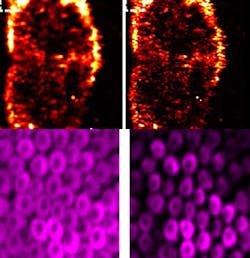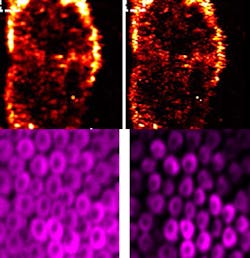Researchers harness photobleaching effect in photoacoustic imaging effectively
Researchers at the School of Engineering & Applied Science at Washington University in St. Louis (Missouri), led by biomedical engineering professor Lihong Wang, Ph.D., have found a way to use the photobleaching effect to their advantage when using photoacoustic microscopy to take a close look at biological tissue. The work also could be useful in early cancer detection.
Related: Photoacoustic tomography is ready to revolutionize
Related: Deep down and label-free: Bioimaging with photoacoustics
The laser beam used in photoacoustic microscopy measures 200 nm wide. However, the center of the laser beam is so strong that it bleaches the center of a tissue sample. When researchers pulse the laser beam on the tissue, the molecules no longer give signals packed with information. Then, a second laser pulse probes the molecules that are left in the boundary of the sample; in this pulse, the molecules in the center of the sample provide a weaker signal because they are already bleached.
"Previously, when a molecule was prone to bleaching, researchers didn't want to use it because they couldn't get enough information from it," explains Junjie Yao, Ph.D., a postdoctoral research associate in Wang's lab. "Now for us, that is good news."
Wang and Yao subtracted the boundary area of the sample, leaving only the center--or what they call a photo imprint--now down to 80 nm wide, providing a super-resolution image. A smaller diameter of the center provides a better resolution in the image. Yao says that by shrinking that detection spot, it enables them to see a lot of subcellular features, such as mitochondria or cell nuclei.
After each area of the sample is scanned, the researchers create an image. With previous photoacoustic microscopy imaging, the microspheres on the image were blurry. However, with the new photo-imprint photoacoustic microscopy technique, the resulting image is clear and sharp.
Those working in imaging could apply this method to their own research, Yao says.
Full details of the research team's work appear in the journal Physical Review Letters; for more information, please visit http://prl.aps.org/abstract/PRL/v112/i1/e014302.
-----
Follow us on Twitter, 'like' us on Facebook, and join our group on LinkedIn
Subscribe now to BioOptics World magazine; it's free!

